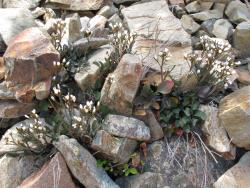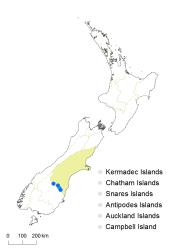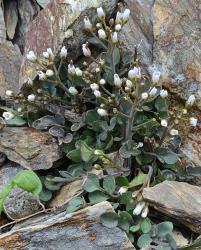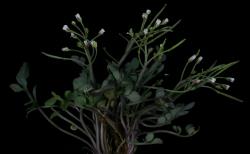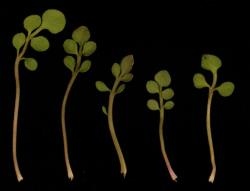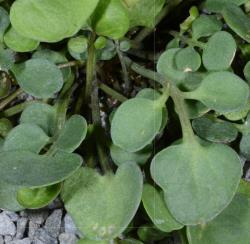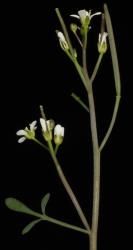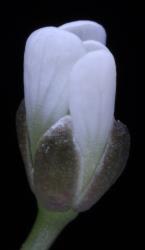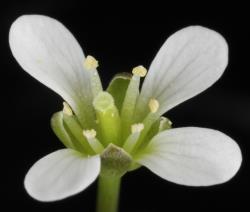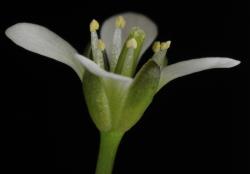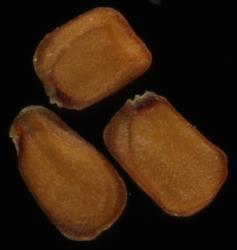Perennial herb, single rosette or with lateral branches. Leaves up to 135 mm long, pinnatisect; lamina 17.0–65.0 × 16.0–42.0 mm, grey to grey-green, coriaceous, glabrous; petiole up to 92 mm long. Terminal pinna 5.7–14.0 × 4.5–9.5 mm, simple, broadly elliptic, elliptic-orbicular, ovate or broadly ovate; margin entire; lateral hydathodes absent; apex obtuse with a distinct hydathode; base obtuse. Lateral pinnae 2–6, 4.4–13.0 × 3.0–9.5, simple, broadly elliptic, elliptic-orbicular, ovate or broadly ovate; margin entire, lateral hydathodes absent; apex obtuse with a distinct hydathode; base obtuse; petiolule 1.8–10.5 mm long. Cauline leaves similar to rosette leaves but smaller, narrower, with fewer lateral pinnae, pinnae bases attenuate to cuneate; terminal pinna up to 20.0 × 5.0 mm, lateral pinnae up to 12.0 × 5.7 mm. Inflorescence racemose, sometimes with lateral racemes, each raceme 6–18‑flowered; peduncle up to 250 mm long, 1.2–1.6 mm diam. at base, ascending, glabrous. Pedicels 10.0–22.0 mm long, 0.4–0.5 mm diam., glabrous. Sepals 2.1–2.4 × 0.8–1.4 mm, elliptic-oblong, saccate, green to red-brown, glabrous, margin white and membranous, apex obtuse, base truncate. Petals 3.6–4.5 × 1.2–1.4 mm, white, limb obovate; apex obtuse; base attenuate, tapering to a 1.0–1.5 mm‑long claw. Stamens 6; median filaments 4, 2.4–3.1 mm long; lateral filaments 2, 2.1–2.9 mm long; anthers 0.3–0.4 mm long, cream, when dehiscent held slightly below the stigma. Ovary 2.5–3.2 mm long, 0.4–0.6 mm diam., ± terete, green-brown, glabrous; ovules 30–32; style c. 0.3 mm long, ± terete; stigma 0.4–0.5 mm diam. Siliques 21.0–34.0 × 1.1–1.3 mm, glabrous, style 0.7–1.0 mm long; valves green-brown at maturity and when dehiscent; replum 0.7–0.8 mm wide. Seeds 1.3–1.4 mm long, 0.8–0.9 mm wide, oblong to orbicular-oblong, yellow-brown; wing absent.
Cardamine thalassica is distinguished from C. glara by being entirely glabrous, with grey to grey-green leaves, leaflets with more distinct petiolules, inflorescence a raceme, shorter petals, and longer seeds.
South Island: Canterbury.
Cardamine thalassica occurs on the Kakanui Mountains and St Bathans Range.
Cardamine thalassica grows on dry, unstable, bouldery colluvium and rocky slopes.
Cardamine thalassica is assessed as having a conservation status of Threatened, Nationally Endangered B(1), with the qualifier Data Poor (de Lange et al. 2018). The qualifier Data Poor is applied because additional information is required on the number and size of the populations and further field work is likely to discover new populations.
Flowering December–March; Fruiting December–March.



